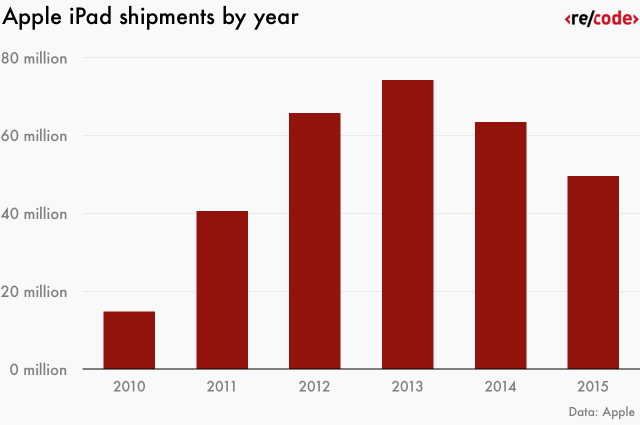iPads in Higher Education
It is now 6 years since the launch of the iPad by Apple. The graph shows the explosive acceptance of it with growing and declining popularity.

While hardware development is leading to a transformation of student learning in and through tablets and smartphones, there have been few changes in teaching practices.
Even more concerning is the lack of research especially related to new iPad initiatives. The touchpads provide alternative potentials for teaching and learning drawing on emerging possibilities.
Biannual iPads in Higher Education conferences began in 2014. During April, 2016 the second conference was held in San Francisco where a relatively small group of conference participants shared their ideas and experiences. The conference schedule is available online. The Sched software links presenters with their short bios and to-be-published book chapters. My presentation titled, “A nomadic research journey: Blogging with an iPad and taking a critical posthuman perspective” is also available here.
Among the conference highlights were
- The value of sharing ideas and experiences within the teaching and learning community. At the California State University there is a regular “Appy Hour” covering different themes. The iPad’s usefulness extends beyond its common role as an e-book. It can facilitate improved productivity, scheduling, quizzing and alternative lecturing possibilities
- The emphasis on creativity in our teaching. An Apple educator pointed out how emergent teaching differs from traditional ways. Here are a few examples in the table below:

- The value of storytelling in Law school at the Western Sydney University where 11,000 iPads have been distributed to every new student and all academic staff. Staff support to introduce teaching and learning innovations has been an imperative part of the success of this project.
- The positive impact of iPads on student group work at Saginar Valley State University. It is not just about providing the tablets but about facilitating a mind shift in educational strategies.
- The move to more personalized learning through using iPads at Auburn College, Alabama where iPads have been adopted, adapted, and integrated into the learning environment. Vicky Cardullo reported on their research survey where findings indicated that 40% of students felt that the iPad helped them become more successful in their first year of studies at the university
The good news for us all is that Adobe has launched an array of free apps that can assist with reflective practices. I wonder how portfolio tasks can be enhanced and become more motivating if students are encouraged to explore multimedia opportunities such as Adobe Voice and Adobe Slate.
- A useful read is: Nguyen, L., & Barton, S. (2014). IPads in higher education – Hype and hope. British Journal of Educational Technology.
